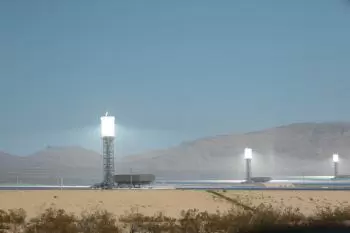
Solar thermal energy is a technology to generate thermal energy using the energy of the Sun. This technology is usually used by solar thermal power plants to obtain electricity.
Solar thermal energy is a renewable energy source and therefore does not emit greenhouse gases.
This electricity generation process is carried out in so-called solar thermoelectric plants or solar thermal plants. The first solar thermal power plants were built in Europe and Japan in the early 1980s.
Conversion of solar thermal energy into electricity
Solar thermal energy is obtained by converting solar heat into useful energy. This is achieved through various technologies.
- Parabolic solar collectors use curved reflective mirrors to concentrate sunlight onto a receiver containing a thermal fluid. The heat generated is used to produce steam and generate electricity.
- Solar tower plants surround a tall tower with mirrors that concentrate sunlight at the top, heating a thermal fluid that also generates steam for electricity production.
- The parabolic dish concentrates sunlight onto a central receiver.
Additionally, many facilities incorporate thermal storage systems to ensure continuous energy generation. Some plants use molten salt as a thermal storage medium, allowing electricity generation even after sunset.
In addition, there are systems based on Stirling engines that convert solar heat into electricity.
Difference between solar thermal and photovoltaic energy
The difference between solar thermal energy and photovoltaic solar energy is the way the energy is used. Solar thermal energy generates thermal energy and photovoltaic electricity.
Solar thermal energy is used to produce domestic hot water that accumulates in water tanks in low-temperature facilities. In thermoelectric plants, solar radiation is concentrated to generate steam with thermal energy. The steam drives turbines and generates electricity.
On the other hand, photovoltaic solar panels only generate electricity with another type of technology: the photoelectric effect. Solar panels are made of a material that when hit by a photon releases an electron, generating an electric current.
Both types of energy can be used to generate electricity, but with different technologies.
Operation of a solar thermal power plant
The operation of a solar thermal plant is similar to that of a thermal power plant or a nuclear power plant. The distinguishing element between them is the fuel or heat source.
Thermal power plants use fossil fuels such as coal or gas to generate heat, nuclear power plants use the nuclear energy present in uranium atoms to generate thermal energy. On the other hand, thermoelectric plants use solar radiation.
The sun's rays are concentrated by mirrors in a receiver that reaches high temperatures of up to 1,000 degrees Celsius. This heat energy is used to heat a fluid and generate steam. The steam generated, which has a high pressure, allows a steam turbine to move. At the same time, this turbine drives a generator that will be responsible for converting mechanical energy into electricity.
Solar radiation concentration techniques
There are different types of concentrators with which different maximum temperatures are obtained with their corresponding thermodynamic efficiencies. They are the following:
-
Parabolic cylindrical solar concentrator. A parabolic cylindrical solar concentrator consists of a linear parabolic reflector that concentrates light onto a receiver positioned along the focal line of the reflector.
-
Compact linear Fresnel reflector. Fresnel reflectors are made of many strips of thin, flat mirrors that concentrate sunlight onto tubes into which the working fluid is pumped.
-
Stirling disk. A Stirling disk is a reflector that follows the Sun in two axes. In particular, the dish is a unique parabolic reflector that concentrates light onto a receiver positioned at the focal point of the reflector.
-
Central tower solar power plant. A central tower solar power plant consists of a set of reflectors called heliostats that concentrate sunlight onto a central receiver installed on a tower. Because the Sun's relative position varies, heliostats must have the ability to reorient themselves using two-axis tracking.
Advantages and disadvantages
Like all technologies, solar thermal power plants have advantages and disadvantages:
Advantages of solar thermal plants
The main advantage is that the fuel used is solar radiation. A free and inexhaustible resource. For this reason it is considered renewable energy. Regarding fossil energy plants, they do not use fossil fuels, therefore they do not emit greenhouse gases and do not contribute to worsening the problem of climate change.
Disadvantages of solar thermal power plants
The main drawback is the schedule and weather, which do not allow for the generation of a constant amount of electrical energy. Initially the first plants could only operate during the hours of solar irradiation, but today it is possible to store heat during the day to produce electricity at night.
On the other hand, the maintenance of these installations involves constantly cleaning large surfaces of reflectors. For this reason, the consumption of water and chemical products is abundant.